Post-Expedition Musings III: Food
For the third in my series of post-mortems on my 2-week kayak camping trip on the West Coast of Vancouver Island, I want to tackle the topic of food. It’s also the longest of all of these articles. Coincidence? I think not!
For some, food is fuel, and little more. Food is indeed fuel, but food is also the hub of most in-camp socializing amongst paddlers, a source of comfort on cold days, and a major element of morale if conditions are tough or things are going wrong. Becoming demoralized at dinner time because you’re starting to find your food uninspiring – or, at worse, unpalatable – is a major issue.
Food fatigue = fueling failure. Poor planning produces peckish paddlers. And other alliterative aphorisms.
I would argue that how much you enjoy what you eat is actually a significant safety and group cohesion issue…and don’t we do these trips to, at least partially, enjoy ourselves?
Food Storage
I touched on this in my last article, but we were in bear/wolf/mouse country, and needed to take food storage seriously. Most of us used BearVault brand containers, but I used Ursacks, because I couldn’t fit rigid bear canisters in the hatches of my boat (see the first article in this series).
(Note to my California comrades: Ursacks are not currently approved by the SIBBG for use in the Sierra Nevada at the time of this writing.)
Everything inside of these bearproof containers were placed in odor-proof bags (which aren’t, really, based on some recent tests done at Backpacking Light, but they do help a bit, and are great in case a spill happens).
All these systems worked well, as inconvenient as opening and closing them were. It does make storing unexpected supplements (caught fish, etc.) or unused meals a hassle, but hey, better that than habituated wildlife eating an unnatural diet.
For two of us, we had 2 full bear canisters and 3 Ursacks to hold all our food and toiletries (remember, anything smelly should go in a bearproof container of some kind).
Dehydration is Awesome
Biologically, no, dehydration isn’t awesome. Gastronomically, it’s fantastic.
A friend let us borrow her dehydrator: As soon as we got back, we ordered our own. Having a food dehydrator rocks. It just does. If you’re willing to put in the extra work in making your own camping food in this way, you get the following benefits:
- You get to experiment like science class. We’ve dehydrated cooked rice, bananas, fake crab meat, turkey cold cuts, romesco sauce, and much more!
- You get to make food with few to no preservatives, so you maintain total control over sodium levels in your food.
- You can pack your food the way you want, possibly reducing waste you need to pack out.
- You can better dial in serving sizes: No one wants to bury uneaten food below the tide line.
- You can test the food to make sure you like it, unlike taking your chances on sealed commercial packets you’ve never tried before.
- Rehydrating pre-cooked grains in the field, like quinoa and rice, takes less time and fuel than cooking them directly.
- If you backpack or camp a lot, it’ll pay itself back eventually, compared to buying commercially prepared dehydrated foods.
Group Meals are Hard
Although most of us were responsible for our own food, we had planned that we’d have a number of group dinners on our trip. This became tougher as the days went on. We’d need a day when we all weren’t so tired from paddling that we all just went for easy individual meals. We’d need enough time to prep, so we’d need to make sure that we didn’t get off the water too late in the day.
Preparing and making meals for a whole group takes a while, and removes one of they key elements of efficiency: Parallelism. Yes, work can be distributed, but at the end of the day there are only so many stoves in the group, and there are often dependencies on doing some steps before others. Group meals can be a rallying point for the group, but unless they are carefully considered and everyone opts in, it can be tricky to plan and pull off efficiently.
The only way around this, I think, is to have all meals be shared, and for food prep roles to rotate – many expeditions work in this way. But only doing it partway didn’t work well for us.
Variety is Essential
We had asian rice and noodle dishes, soups, two or three different kinds of curries, crab salad, and more that I can’t recall. We had a couple different kinds of trail mix for on-the-water snacking. It really helped us stave off food fatigue, and made dinner selection more fun: Do we have this, or that, or that, or that?
Even though our menu was limited by what foods would pack well and would keep, these small choices were fun, morale-building moments.
The caveat was that all that variety increased meal planning times significantly, and resulted in no efficiencies of scale, so our food took up a ton of room.
Stove Selection
Being a lightweight backpacker, I use the Jetboil when I camp. This has become the mainstay of my cookset. Another member of our group brought one, too: It was nice to have a safety backup in case something when wrong with mine. Simple, fast, and easy.
Other companions brought a white gas stove. While more fiddly and potentially hazardous, this had a huge advantage: We were offered fresh-caught salmon for free. (It was the Pacific Northwest, after all.) If all we had were Jetboils, actually cooking something (as opposed to boiling and rehydrating) would have been hard, and possibly ill-advised. (I opted out of the fresh fish, myself, as I needed to eat down my own food stocks in order to fit in an upcoming resupply!)
Long story short: If you can manage backups, you should, and a variety of stove types provides a lot more flexibility.
A Note About Libations
Booze is as personal as food. When I camp, I love a little unwinder, but I don’t bring too much high-test stuff. I battle with dehydration daily as it is, and I always want to be ready to make major miles each day if I have to, which requires feeling good every morning.
On this trip I brought a nice rye whiskey and wine, but as always, I do not travel with glass. It’s heavy and doesn’t reduce in size as you consume its contents. If it breaks on a beach, it makes leave-no-trace packing pretty hard. And glass shards and dry bags don’t mix.
Boxed wine is the best form factor, and BotaBox makes some shockingly nice red wine. For harder stuff, look into Rum Runner plastic flasks. If you’re into beer, rejoice: The microbrew age has brought us a slew of amazing beer in cans (light and crushable for packing them out!). My favorite canned beer is a locally made but widely distributed San Francisco black IPA from 21st Amendment.
Snackysnacks
Eating on the water just happens – sometimes it has to happen. The outdoors mainstream wants you to eat energy bars, gu packets, or energy drinks. We do, too, they absolutely have their place. But GORP (Good Ol-fashioned Raisins and Peanuts) or trail mix has its advantages: It’s a perfect mix of carbs, protein, and fat (chocolate chunks are a requirement!), most folks can digest it well on the go, it’s calorically dense, and for kayaking it stores very well. We also like using salty Asian snack mixes and even Indian-spiced chickpea snacks. It’s great to have separate savory/salty and sweet within arm’s reach.
We bring large “master” bags of snacks and empty a day’s ration into something we can have within arm’s reach. There are no individual wrappers to dispose of as with prepackaged commercial foods(or, worse, lose in the ocean). We found that the perfect daily serving fit in 4-ounce plastic spice jars (mentioned by Ms Brinestorm in her recent guest post on endurance kayak racing), which you could just uncap, shake into your mouth, and put away. We’d eat about 2 ounces between each major meal for most days under 20 miles. Efficient, easy, no waste…and fits in a PFD, drysuit shoulder pocket, “glove box” hatch, or deck bag.
Thermoses for Hot Lunches
One person in our group spent a month kayak camping in Alaska, and she developed a system for hot lunches using 16-ounce insulated food or soup containers. We decided to give it a try, using actual Thermos brand containers, although we were all pretty jealous of our friend’s Hello Kitty container.
Short, wide-mouth designs are far superior compared to tall, narrow-mouth designs. For many meals, it’s best to select foods that will rehydrate relatively quickly, say, about 10 minutes. But if you were to start a meal hydrating while you were eating breakfast, it could rehydrate for hours, as long as you could keep the heat in (the water needs to stay really hot until eating, not just lukewarm).
Just make extra hot water with your breakfast and pour it into your insulated lunch container. This opens up more possibilities for basically slow-cooked foods like noodles and soups that would take too long to rehydrate in camp. We actually ate lunch in our boats once or twice, due to a lack of landing spots, and eating out of thermoses was super easy on the water. Plus, hot lunches on cold, damp days is an utter luxury.
There are two things to watch out for with this technique, though.
- The liners between the double walls of any insulated container can crack or break, so keep checking the exterior: If the exterior gets warm, you’re losing heat, the food won’t heat properly (leading to food safety risks), and the container will need to be replaced. So take care not to drop them.
- Insulated food containers usually have rubber or silicone o-rings to keep them spillproof. Rodents love to nibble on them, especially since they smell and probably taste like what you last made in them, even after washing. Once those o-rings are shot, the container loses a most of its effectiveness…and may leak badly. Wash them, then close them completely overnight, even if they’re wet.
A Word on Water
We knew where fresh water was thanks to GPS waypoints of previous travelers, and we always carried 3-4 days’ worth of water in MSR Dromedaries. We went through about 5 liters of water per day per person, when you included a small hot-water facial rinse each day, drinking, coffee, and cooking. We never ran out of water, yet used pretty much every drop. We used salt water and salt-water soap for cleaning our eating utensils and dishes, which helped conserve our drinkable water supply.
We filtered water with a Sawyer Squeeze, which was flawless (but always take the cleaning syringe with you), but the included water bags have sketchy reputations for breakage and leaks, so we replaced them with two 1.5L Evernew water bags that were bombproof. The Sawyer Squeeze is so small, and so vital, that I could see a good argument for carrying two to speed up filtering at mosquito-infested springs, if you have two people to do the filtering.
We also got into the habit of carrying some unfiltered water for cooking and washing at all times. This extended our drinking water considerably. Be sure that you and your companions always can identify what bags are reserved for unfiltered water: Our rule was Dromedaries for Drinking: The Evernew bottles were never to be sipped from directly.
Post-Mortem
Even with all these strategies, we ran a serious calorie deficit for the first week. We stopped at the Kyuquot Inn to pick up our 2nd week’s food cache and had lunch there – actually, two lunches. Each. That was quite an eye opener, and for the second week we started eating more, and using more calorically-dense supplements to our food, like olive oil. But, when we arrived back at our car at Gold River, BC, we had very little extra food left. Like on a backpacking trip, you want to have just enough of a safety margin to leave the trail with a little extra food, but not so much that you carried a lot of extra weight for nothing.
We over-packed in terms of food. This was on purpose, as this was a shakedown cruise for all manner of new homemade food recipes and meal prep styles. We had a different meal every single night! This was one of the reasons that we could only bring 1 week of food with us in expedition-sized boats. With a bit more planning and a smidge less variety, I think we could easily pack for 10-14 days without resupply, and not get food fatigue.
Next time around we’ll be even more adventurous with dehydrating, probably would bring more wine (two 3L bags for five people for two weeks was a pretty tight ration), and probably more chocolate.
Always, always more chocolate.
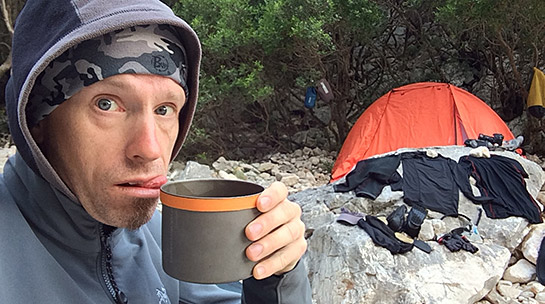

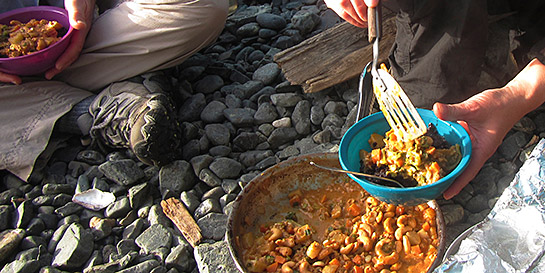
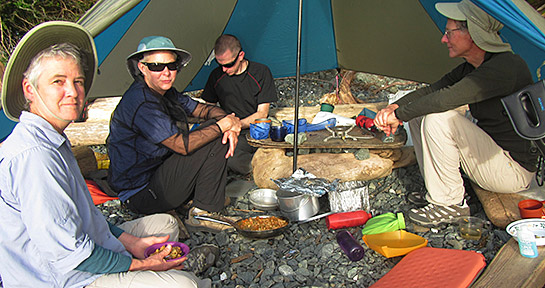
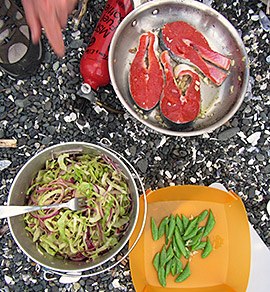
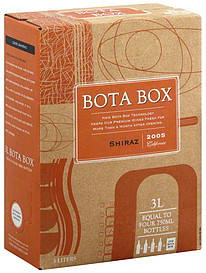
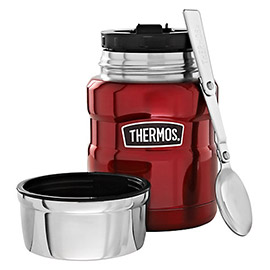
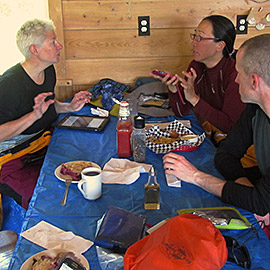
Another great article! I have been trying for days to figure out what to bring this weekend. Great ideas!